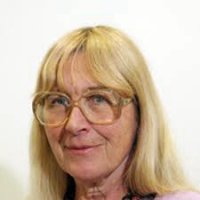I am delighted and honoured to be able to write about my dear friend and colleague, BAAT’s former Hon. Vice President, Joan Woddis. My challenge is to do justice to someone who has contributed to our profession in so many different ways, since 1980. Working with Joan, at Goldsmiths, at the Council for Professions Supplementary to Medicine (CPSM), in BAAT and the HCPC, was a privilege and something I, and generations of students and colleagues will always value enormously. Joan is now past her 90th year but retains that feisty approach combined with a wicked sense of humour and wit that served us so well during the many tricky periods we had to negotiate on the way to becoming a statutory regulated profession – and before that, to achieving support and recognition within our own institution, Goldsmiths, for both the MA in Art Psychotherapy and the Postgraduate Diploma in Group Psychotherapy.
Incidents of mind-blowing awfulness, in which we retired to a quiet room in our old base in Albury Street, Deptford, and then the ramshackle No. 21 St James, to rant and rage, were quickly followed by refusal to succumb, and making cool, strategic plans for attack. Most of the time the bizarre actions we were confronted by were occasioned by misunderstandings or indeed mistakes by those in authority. They were not rational and thus could be challenged through recourse to actual documents, often those issued previously by the same authorities! Having the sense of humour and confidence in our work shared by Joan, myself and on many occasions by Andy Gilroy or others of our colleagues in Goldsmiths and BAAT, was vitally important in putting such incidents into perspective and to pressing on.

So, to some details. Joan trained as an Art Therapist* at Goldsmiths in 1979-80, on what was then the Postgraduate Diploma – a specialist in-service programme for qualified teachers. Joan had a long career as an Art specialist teacher having joined ILEA’s special education service in the 1960s. She had taught many children with a range of physical and emotional difficulties, had run ceramic classes in a Borstal, and worked with adult stroke survivors and people with Parkinson’s. Joan brought all this experience and a desire to deepen her understanding of mental health issues into the Diploma programme, and, needless to say, she made a very positive contribution. Following this, she joined the Art Therapy team on a part-time basis and also joined BAAT, in September 1980.
This was a very significant period for art therapists, as we had been making a strong case to the DoH Whitley Council for recognition of the arts therapies, in terms of a discreet career and salary structure in the NHS. In 1981 we achieved this goal, meaning that job opportunities opened up and that we no longer had to struggle so much to be accepted as a profession worthy of a modest salary and the term ‘art ladies’ began to be, slowly, relegated to the bin! Joan, with her strong political background and work experience in inner London schools, quickly became involved with the further development of art therapy post-Whitley – namely in the negotiations to have the arts therapies ‘State Registered’ as the term was then.
Joan always had a strong conviction that the grass roots values of BAAT needed to be retained, that the membership was our strength. We were a very small profession, at that time around 220, and in great need of good political strategy to achieve our aims to provide the best possible service for patients, many of whom had been neglected by the wider NHS services, and our aim to look after our members’ interests and be a ‘learned society’. When Joan became Chair (1985-89) she regularly consulted the members, in particular on two major developments: devising the first Principles of Professional Practice (with Caroline Case) in which all members were asked to evaluate what was necessary for the safe and effective practice of Art Therapy. It’s fascinating now to note that the sole common requirement from all members was for a sink and running water!
Then, around 1989, a senior civil servant at the DoH questioned the necessity for art therapists to both have a postgraduate training AND to proceed towards statutory regulation. This was based, again, on a serious misunderstanding about the nature of the arts therapists’ role. I found myself having to defend a question as to ‘Why, as music therapists just play records of Beethoven, do they need a postgraduate degree in Music Therapy’! Sharing this, and many other outrageous remarks with Joan caused us much mirth as well as indignation, so she took on the task of writing (pre-email) to all members asking them to canvas support and validation from senior colleagues at their place of work. They were provided with a concise statement about the nature of art therapy and the role of therapists, plus a case for needing a postgraduate training. Joan recalls the overwhelming positive response, (including one from Chief Justice Pickles), which we christened the Dorling Dossier! Two thick files of supporting statements were presented to the DoH, occasioning some astonishment from that quarter and, it has to be said, much admiration!
Thus began the campaign to achieve statutory regulation with the CPSM, which was the regulator of what are now known as Health Professions, a move which had been fully endorsed at BAAT’s AGM. This campaign, and Joan’s role in it, needs a paper of its own. It was a co-ordinated effort which included all four of the arts therapies, and required many meetings and sharing of numerous documents. Joan wrote a question for Parliament about the number of art therapists employed outside the NHS, which was asked in the Commons by Doug Hoyle. Doug Hoyle was one of the ASTMS (our Union) MPs who had been so helpful to us in informing us on strategy. Between 1990 and 1997, these negotiations flourished with the support of the Registrar at the CPSM, Rod Pickis – ironically the same person I had cause to inform about the nature of Music Therapy while he was at the DoH, and who experienced not a little embarrassment to encounter me again!
Joan gave the verbal presentation and arguments for our inclusion on the Register to the Council of the CPSM in 1996, warmly supported. Then, Joan and I attended the discussion to amend the Bill to the Act of the Professions Supplementary to Medicine (to include Art, Drama and Music Therapy) at the House of Commons, and on its successful passing, at the House of Lords in 1997. Thus, though the massive efforts of our members, their excellent work within NHS and other services, the recognition of this by many employers and prominent members of the public, we became part of the Establishment, a State Registered Profession. We had our own Arts Therapists’ Board, together with its Education and Training and Disciplinary Committees, retaining a close relationship with BAAT. Significantly, at that time, the CPSM was being restructured and the regulation of Health Care Professions was being brought up to date (bear in mind the CPSM Act was in 1961!) so we were present at the formation of the Health Professions Council, and were able to participate actively in the building of this new structure. Joan has acted as a consultant Partner to the HPC (HCPC) since its inception till very recently.
This is a rather complex history and I have presented just a tiny amount to give readers an idea of the complex range of activities that Joan has undertaken on our behalf. While at Goldsmiths, on becoming a Senior Lecturer, she was responsible for Admissions and other administrative duties, as well as running supervision and experiential groups, visiting placements and contributing to the art workshops for our students. She also externally examined students in Spain, Sweden, the Netherlands, Italy and Russia, attended and contributed to AATA conferences in Chicago and Washington DC, and lectured to psychology students at the University of Toronto.
Joan reminded me, on one of those days when we were reminiscing about past events, about the BAAT/SIPE (Society for Study of the Psychopathology of Expression based in France) Conference in 1985. I thought about this a lot last year at the incredibly successful BAAT/AATA Conference in July, and recalled that quite a few participants had indeed attended that Conference! Although somewhat older, gleeful recognition took place. At the 1985 event, we had a very glamorous reception at County Hall in the final days of the GLC, as well as a lively programme of social events throughout the week. Joan’s international contacts were invaluable in making this a memorable event. Mounting such conferences is exceptionally time-consuming and exhausting, and BAAT’s ability to do this depends, as ever, on total commitment of the members involved, as we are not a wealthy organisation.
Moving to yet another of Joan’s contributions (as if the above was not enough), Joan decided to join the small band of Group Psychotherapists in the Art Therapy Unit at Goldsmiths, and trained as a group analyst from 1981-84, and practised at the West London Clinic of Psychotherapy from 1985 to 95. When our team designed and had gained approval for the postgraduate Diploma in Group Psychotherapy, Joan taught and supervised and was very involved in our aim to produce a truly intercultural experience for our trainees. By this I mean actively seeking to involve Black and Minority Ethnic students, given that both arts therapies and psychotherapy are woefully under-represented by BAME therapists. The links between these two aspects of the Unit’s work contributed to the appreciation of Goldsmiths as a place ‘which took groups and intercultural practice seriously’.
I’m conscious that in this brief account of the contribution that Joan has made to all aspects of our profession, many things have been omitted. Many art therapists will of course know Joan well, having been students or colleagues in BAAT. Others will just have a slight acquaintance of this exceptional person. Retirement is not really a word in Joan’s vocabulary, and she continues to be interested and involved in art therapy and all that surrounds it. We have achieved a lot as a small group of art therapists with little external funding. I emphasize that this is because of the nature of our membership which has been to understand and to rise to the many challenges we have, and still do face, the latest being, of course, coronavirus.
I began to write this piece a few months ago before it happened. I am personally very glad to know that I can pick up the phone to Joan and share the many difficult feelings we are experiencing, knowing just how hard things are for us, as health and social care practitioners, as artists, as art therapists, and for our frontline medical colleagues. The political, rational and critical perspective that Joan can bring to these discussions is something that has characterised her work and life throughout her years. A strong sense of positive values, grass roots activity and belief in involving as many people as possible in decision-making, together with a great sense of irony and fun has never waned.
Thank you, Joan, for being such a marvellous friend and colleague!
Copyright (c) The British Association of Art Therapists (BAAT)
This article is published in BAAT Newsbriefing Summer 2020 and may not be distributed or published without the consent of BAAT

